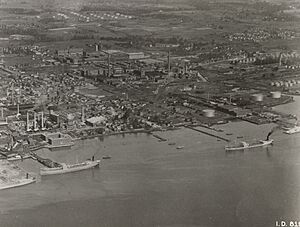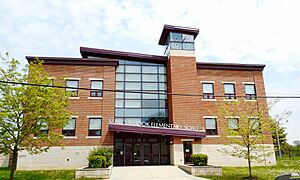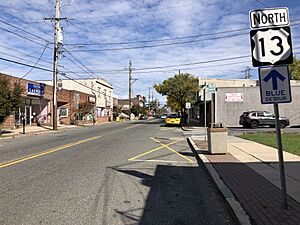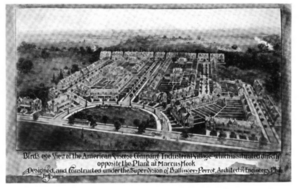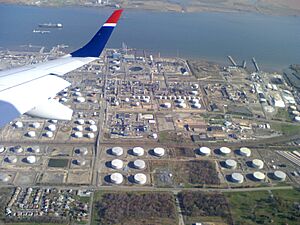Marcus Hook, Pennsylvania facts for kids
Quick facts for kids
Marcus Hook, Pennsylvania
Marreties Hoeck
|
|||
|---|---|---|---|
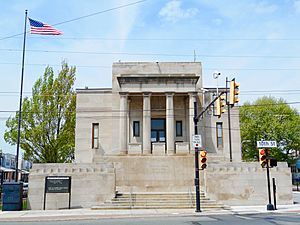
Marcus Hook Borough Hall
|
|||
|
|||
| Motto(s):
The Cornerstone of Pennsylvania
|
|||
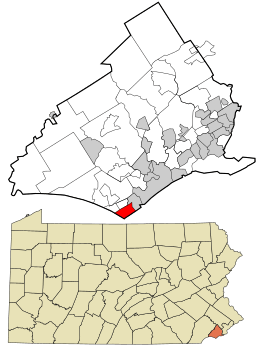
Location of Marcus Hook in Delaware County, Pennsylvania (top) and of Delaware County in Pennsylvania (below)
|
|||
| Country | United States | ||
| State | Pennsylvania | ||
| County | Delaware | ||
| Established | 1655 | ||
| Area | |||
| • Total | 1.62 sq mi (4.21 km2) | ||
| • Land | 1.11 sq mi (2.87 km2) | ||
| • Water | 0.52 sq mi (1.34 km2) | ||
| Elevation | 30 ft (9 m) | ||
| Population
(2020)
|
|||
| • Total | 2,454 | ||
| • Density | 2,214.80/sq mi (854.89/km2) | ||
| Time zone | UTC-5 (EST) | ||
| • Summer (DST) | UTC-4 (EDT) | ||
| ZIP Code |
19061
|
||
| Area codes | 610 and 484 | ||
| FIPS code | 42-47344 | ||
Marcus Hook is a small town, called a "borough," in Delaware County, Pennsylvania. In 2010, about 2,400 people lived there. The town's mayor is Gene Taylor. Marcus Hook is proud to call itself "The Cornerstone of Pennsylvania." A movie called One Last Thing... was even filmed there in 2005!
Contents
History of Marcus Hook
Early Inhabitants
Long, long ago, the first people to live in the Marcus Hook area were the Lenape Native Americans. Their ancestors lived here for thousands of years before European settlers arrived.
The 17th Century
The Lenape had a big settlement in Marcus Hook. In the 1640s, colonists from New Sweden set up a trading post here. They called the village Chammassungh, which meant "Finland." It was on the west side of the Delaware River.
In 1655, the Dutch took over the area. They renamed the settlement "Marrites Hoeck". The name "Hook" means a point of land sticking into the water. "Marcus" comes from the name of an Indian chief called Maarte by the Dutch.
Later, English colonists took control from the Dutch. They built St. Martin's Church in 1699. It opened for worship in 1702. This church was a place for Christians who were not Quakers to worship and be buried.
The 18th Century
Marcus Hook grew into a busy community and market town. By 1708, it was as important as nearby Chester, Pennsylvania. Both towns had about 100 houses.
In the early 1700s, Marcus Hook was a hiding spot for pirates. These pirates caused trouble on the lower Delaware River. The market in Marcus Hook was a good place for them to sell stolen goods. They could also get supplies there, away from the authorities in Philadelphia. Old maps of Marcus Hook show that the current Second Street was once called "Discord Lane." This was because it was where the pirates would party when they were in town.
The Marcus Hook Plank House is a historic building. People say it was once the home of Margaret, a Swedish woman who was a friend of the famous pirate Blackbeard.
By the mid-1700s, Marcus Hook became a major center for building wooden sailing ships. This continued until the late 1800s. After that, larger ships became more popular than the smaller sloops and schooners built in Marcus Hook.
During the American Revolutionary War, special underwater barriers were placed in the Delaware River at Marcus Hook. These barriers, called chevaux-de-frise, helped protect Philadelphia from British warships. Marcus Hook also served as a training area for the Pennsylvania militia. The Continental Army stayed in Marcus Hook in the fall of 1777. Because the town was attacked by British ships, there are very few houses left from before the Revolution.
The 19th Century
Marcus Hook was an important defense spot along the Delaware River during the War of 1812. More than 5,000 United States troops were stationed there.
The town officially became a borough on March 7, 1892. Trains, roads, a deep water port, and the country's need for oil helped refineries become the main industry in the borough.
The 20th Century
The Sun Oil Company opened the Marcus Hook refinery in 1901. It processed crude oil brought by ship from Texas. This was the first of seven large refineries that made the area the biggest fuel-making center in the Northeast. The refinery closed in 2011 because of tough market conditions. However, it later reopened as the Marcus Hook Industrial Complex. It is now run by Energy Transfer Partners. It processes natural gas from the Marcellus Shale, which comes through the Mariner East and Mariner XL Pipelines.
In 1910, the American Viscose Corporation opened a factory in Marcus Hook. This factory made rayon and other man-made fibers.
On February 4, 1932, a Sun Oil tanker ship, the MS Bidwell, exploded and burned. This happened at the Sinclair Dock while its tanks were being cleaned. The explosion killed 17 or 18 people, including the entire crew. This disaster led Sun Oil to develop new safety systems for their ships.
Geography and Climate
Marcus Hook is located on the southern edge of Delaware County, Pennsylvania. It is next to Lower Chichester Township and the borough of Trainer. Across the Delaware River to the southeast is Gloucester County, New Jersey. To the southwest is New Castle County, Delaware. The southern border of Marcus Hook is part of the Twelve-Mile Circle, which is the border between Pennsylvania and Delaware.
Marcus Hook has a total area of about 1.62 square miles (4.21 square kilometers). About 1.11 square miles (2.87 square kilometers) is land, and 0.52 square miles (1.34 square kilometers) is water. The lowest point in Pennsylvania is in Marcus Hook, where the Delaware River flows into Delaware. The borough has a warm, humid climate. Average monthly temperatures range from 33.1°F (0.6°C) in January to 77.9°F (25.5°C) in July.
Education in Marcus Hook
Marcus Hook is part of the Chichester School District. This district includes:
- Marcus Hook Elementary School (for grades K-4)
- Chichester Middle School (for grades 5-8)
- Chichester High School (for grades 9-12)
All three of these schools are located in Marcus Hook.
The local Catholic school for grades K-8 is Holy Family Regional Catholic School in Aston. Marcus Hook used to have its own Catholic school, Immaculate Conception School. It closed in 1974. Its students moved to other schools, which later combined into Holy Family in 2012.
Population and People
| Historical population | |||
|---|---|---|---|
| Census | Pop. | %± | |
| 1900 | 1,209 | — | |
| 1910 | 1,573 | 30.1% | |
| 1920 | 5,324 | 238.5% | |
| 1930 | 4,867 | −8.6% | |
| 1940 | 4,123 | −15.3% | |
| 1950 | 3,843 | −6.8% | |
| 1960 | 3,299 | −14.2% | |
| 1970 | 3,041 | −7.8% | |
| 1980 | 2,638 | −13.3% | |
| 1990 | 2,546 | −3.5% | |
| 2000 | 2,314 | −9.1% | |
| 2010 | 2,397 | 3.6% | |
| 2020 | 2,454 | 2.4% | |
In 2020, the population of Marcus Hook was 2,454 people.
According to the 2010 Census, most people in Marcus Hook were White (82.3%). About 13.6% were African American. A small number of people were Native American (0.1%) or Asian (0.4%). About 3.0% of the population was Hispanic or Latino.
In 2000, the average household size was 2.52 people. The average family size was 3.18 people. About 28.1% of the population was under 18 years old. The median age was 34 years.
Transportation Around Town
As of 2020, Marcus Hook had about 7.25 miles (11.67 km) of public roads. Most of these roads are maintained by the borough.
U.S. Route 13 (also called 10th Street) is the main road in Marcus Hook. It goes northeast to Chester and southwest to Wilmington, Delaware. Pennsylvania Route 452 (Market Street) crosses US 13 in the town center. It leads north to Interstate 95 and U.S. Route 1.
The Marcus Hook station is a train station for SEPTA. You can take a train from here to Center City Philadelphia, Wilmington, and Newark, Delaware. The SEPTA Route 119 bus also serves Marcus Hook. It travels between the Chester Transportation Center and Cheyney University.
Notable People from Marcus Hook
Many interesting people have connections to Marcus Hook:
- Ron Bennington: A radio personality on Sirius XM.
- William Bucknell: A businessman who helped fund Bucknell University. The university is named after him.
- Elisha Cullen Dick: A doctor who cared for George Washington when he died.
- Ralph Garzia: A Pennsylvania State Representative.
- John Grubb: An early settler and member of the Pennsylvania Provincial Assembly.
- Robert E. Haebel: A major general in the U.S. Marine Corps.
- Billy "White Shoes" Johnson: A former professional football player.
- Albert Dutton MacDade: A Pennsylvania State Senator and Judge.
- Mickey Vernon: A professional baseball player.
- Curt Weldon: A former U.S. Representative and mayor of Marcus Hook.
Religion
The Roman Catholic Archdiocese of Philadelphia manages Catholic churches in the area. Immaculate Conception of Lourdes Church in Marcus Hook opened in January 1917. In 2013, this church merged with St. John Fisher Church in Upper Chichester Township. The Immaculate Conception parish then closed.
See also
 In Spanish: Marcus Hook para niños
In Spanish: Marcus Hook para niños






